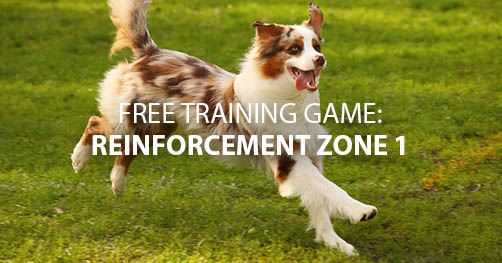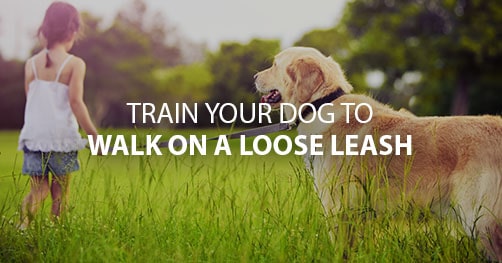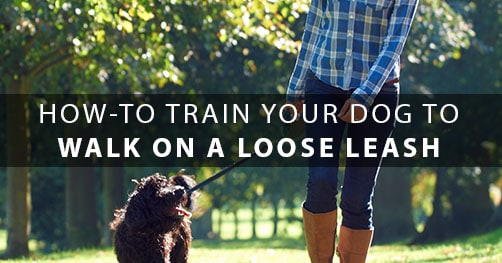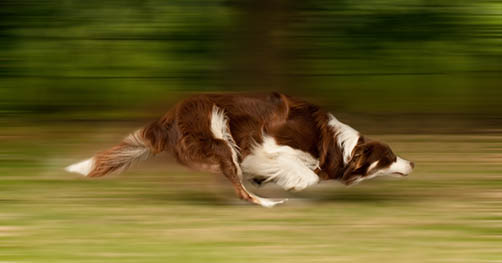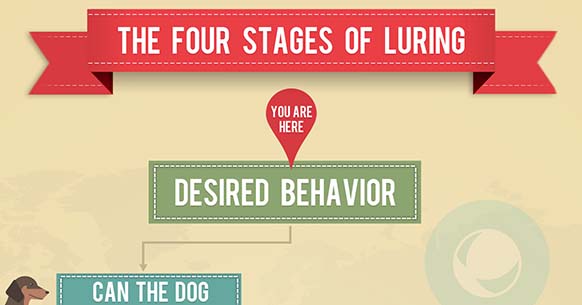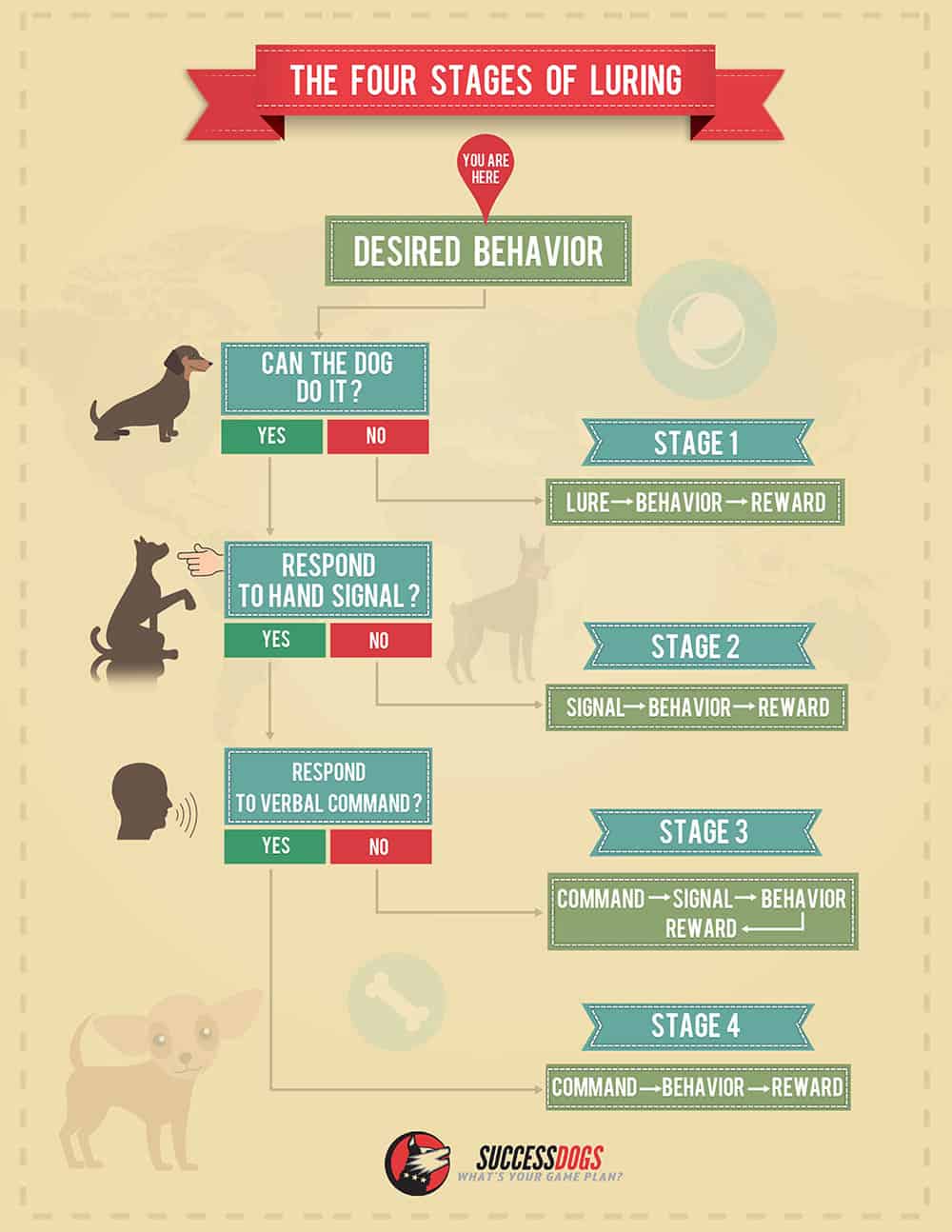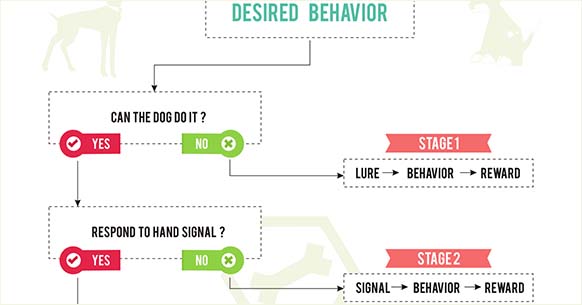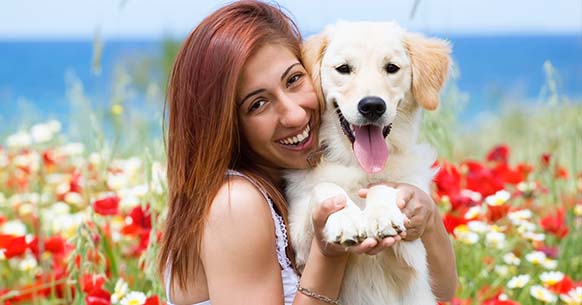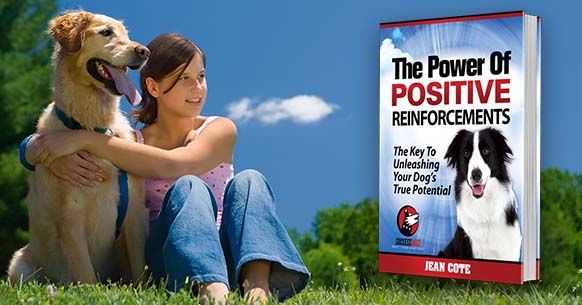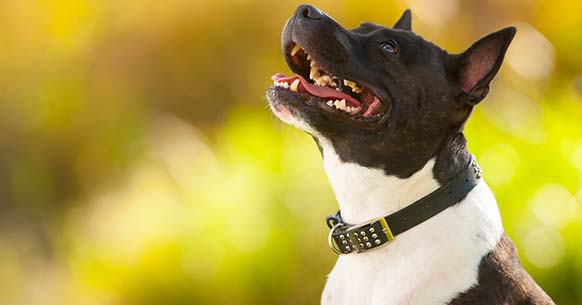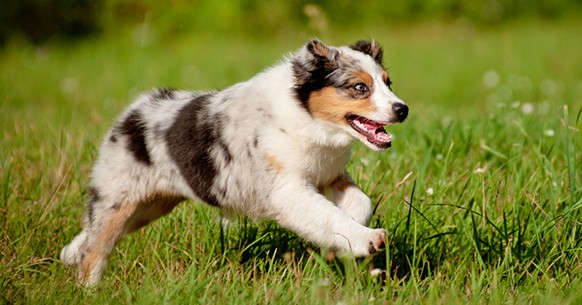Free Training Game – Reinforcement Zone 1
Wow! I’ve received such positive feedback from my 3-part series on training dogs to walk in harmony…
But after reading dozens of emails, I realized many people are still struggling with their dog pulling them on the leash.
So I decided to give you a FREE training game…
Inside this training game, you will learn the best strategy to reward your dog for walking nicely with you.
Because most dog owners have the wrong approach. They focus on punishing their dog for pulling instead of rewarding their dog for walking nicely with them.
Which leads to all sorts of problems…
The biggest of them all is it takes the fun away from walking your dog. It leaves you in a negative mindset and scares your dog as he tries to avoid being punished.
So take a moment to watch this training game, and more importantly practice the technique with your dog during your next walk.
You’ll be glad you did.
Click the play above button to watch the video.
YOUR NEXT STEP:
Like this training game? There’s 23 others like this one inside my Walk In Harmony Game Plan. Click here to learn more about it, your dog will be glad you did!
Five Good Reasons You Should Train Your Dog to Walk on a Loose Leash
In the first article of this series, I shared my steps for training your dog to walk on a loose leash and stop pulling once and for all.
For some reason, whenever I discuss these training steps with my students, they always want more information. They want more details—almost like they’re looking for that secret piece of the puzzle that will magically transform their pets into perfect walking dogs.
However, the sad truth is that there’s no such thing. Nothing replaces hard work, and if you want a dog that walks on a loose leash, then you will have to take the time to train your dog.
I will admit that most people don’t find this proposition attractive. They think to themselves, You mean I have to train my dog? That’s way too much work!
Yes, that is exactly what I’m asking, but you don’t have to take any extra time out of your day. All you have to do is replace the time you’re already taking to walk your dog and replace it with the time you use to train your dog. Simple, right?
I wish all dog owners did this with their dogs. Unfortunately, even after I’ve laid out my logical case, most people still won’t take the time to train their dogs to walk on a loose leash. It requires effort, dedication, and energy.
So in this article, I’m going to share with you five good reasons you should train your dog to walk on a loose leash (and to stop pulling). These reasons are meant to energize and motivate you to take action and begin training your dog.
Reason 1—The longer you wait, the more your dog will pull on the leash.
It’s no secret that many dog owners will tolerate their dogs’ habit of pulling them. Many think it’s a normal part of owning a dog, whereas others simply don’t know what to do or how to solve the problem.
Either way, the longer a dog gets away with pulling on the leash, the harder it’s going to be to curb this habit, which is caused by self-rewarding behaviors—which is explained in detail in the first article of this series.
This is why training a puppy is so much easier than training a full-grown dog. A puppy has not yet developed the bad habits of walking ahead and pulling on the leash. You can get a puppy to walk nicely beside you in just a few training sessions.
Now, that’s not to say you can’t train an older dog who has been pulling for months or even years. You definitely can do it. However, it will be more challenging because you will need to replace the old habits of walking ahead and pulling with new ones such as walking by your side and paying attention to you.
Reason 2—Pulling is a serious safety issue.
Walking a dog that constantly pulls on the leash is not a pleasant experience, and in some cases, the dog pulls so hard that it causes physical pain in the owner’s hand, wrist, arm, or shoulder.
I recently had a student enroll in my Walk in Harmony Game Plan who had had an incident with her dog and needed surgery on her shoulder. She was walking her dog when, all of a sudden, her dog saw a squirrel and decided to run after it, putting massive strain on her shoulder.
Another student of mine suffered from a broken wrist because her dog was pulling on its leash during a winter snowstorm. She didn’t realize that her dog was pulling her toward an icy patch, and she ended up slipping and having to go to the hospital.
I even had another student tell me a story about when she almost got hit by a car because her dog decided to pull her toward a busy intersection. She was walking a big German shepherd, and had she not dropped to the ground to make her dog carry all of her weight, both she and her dog would have been hit by a car.
Now, these cases might seem extreme, but they are real stories from ordinary dog owners who never took the time to train their dogs to walk on a loose leash. They were just too busy with life, and their dogs’ tendency to pull them wasn’t a big enough problem.
My advice is to not wait until it’s too late before doing something about your dog’s pulling behavior. I know that prevention isn’t easy, but if it can prevent an injury, it’s time well spent, in my opinion.
Reason 3—Pulling on the leash often leads to less exercise.
Did you know that humans will do more to avoid pain than they will do to gain pleasure?
This simple fact is also at play for dog owners training their dogs to walk. For example, if your dog is constantly pulling and dragging you around the block, you will experience physical discomfort from a sore hand, wrist, arm, or shoulder.
On top of that, there’s also the emotional pain of what others will think of you. Often, people will make the assumption that you’re a bad dog owner simply because your dog is pulling you on the leash.
I had a student in my Walk in Harmony Game Plan tell me how her neighbor told her silly things as she walked her dog such as “You should have a sled,” “It’s a good thing you don’t have a big dog,” and “Your dog is sure leading the way!”
Of course, her neighbor was just trying to be funny and didn’t intend for those comments to be hurtful. But sometimes what others say can influence us more than we realize, and we can easily associate physical and emotional pain with walking our dogs, which leads us to unconsciously walk them for shorter distances and less frequently.
Another student of mine presents a perfect case of this. She was so ashamed of what other people thought of her while she walked her dog that she would only walk her dog late at night or early in the morning when it was still dark so that nobody could see her getting dragged down the road.
The overall problem is that dogs need lots of daily exercise to release their excess energy, and if you end up walking your dog for shorter distances and less frequently, it will be getting less exercise. If your dog doesn’t have an outlet for excess energy, it will find another way to get rid of it, even if that means doing destructive things such as barking, digging, and chewing.
My sister had this exact problem with her dog a few years ago. Her dog was constantly chewing shoes and furniture. All of that stopped when she started walking her dog for an hour twice per day—her dog simply wasn’t getting enough exercise.
Reason 4—Be able to go anywhere with your dog.
Wouldn’t it be great if you could go anywhere with your dog? This is why I’m so passionate about loose leash training. I want dog owners to be able to go to the park, attend public events, hike, jog, or even take a trip to their local pet store with their dogs. Why should anyone be restricted to just going around the block?
Not only are longer walks beneficial to your dog’s health and well-being, but they’re also great for getting rid of stress. So many of my students live hectic lives with busy schedules, and they tend to be exhausted when they come home at night. The problem is that walking their dogs becomes a chore rather than a way to relax and be out in nature with their dogs.
That’s why taking the time to train your dog to walk on a loose leash is so important. Once you’ve trained your dog, you can go wherever you want, whenever you want. Walks are no longer stressful situations.
Reason 5—Training transforms your dog into a happier, better-behaved family pet.
When I ask my students why they decided to get dogs, they usually tell me it’s because they thought getting a dog would bring happiness to their lives, that their dogs would cheer them up when they felt alone or sad, or that having a dog would give them a reason to get out of the house. But these reasons somehow get forgotten over time, and the struggles of owning a dog become the main focus.
I’ll admit that it’s important to address any behavioral problems that come up with your dog; however, it’s just as important to remember why you’re doing all of this in the first place. Focusing on the problem doesn’t solve it. Focusing on the solution does.
What will motivate you to seek the solution is the vision of why you wanted to get your dog in the first place: the moments you imagined sharing with your dog and the positive things you thought it would bring to your life. If you can get through the tough times, even when it seems like there’s no hope for you or your dog, your relationship will grow stronger. It’s kind of like a couple getting through a rough time. Maybe it’s someone getting laid off at work or a death in the family. It’s extremely difficult during those times; however, once they’ve passed, the couple can look back on them and smile because those events made them stronger.
The same is true with training your dog to walk on a loose leash. It may seem hopeless right now, but it can be the time when you learn how to properly train your dog by using positive reinforcement. If you take the time to master these training techniques now, you’ll not only get a dog that walks on a loose leash but also one that wants to please you in the future. Because the training methods I share in my Walk in Harmony Game Plan are widely applicable, you can use them to get your dog to do almost anything.
Many of my students continue to train their dogs beyond the scope of the program. They’ll use what they learned to teach their dogs to do tricks and all sorts of other neat stuff.
PART 3:
In the final part on this series on training your dog to walk on a loose leash, I’m going to share some real-life success stories of how my students used my Walk in Harmony Game Plan to get their dogs to walk on a loose leash and how you can do it too. Stay tuned.
The Ultimate Guide on How to Train Your Dog to Walk on a Loose Leash
Is your dog pulling you on the leash? If so, then you’ve come to the right place. In this training guide, I’m going to share with you four training steps to getting your dog to walk nicely on a loose leash with you and to stop pulling once and for all.
Now, before we dive into the actual training, I’d like you to meet Sophie.
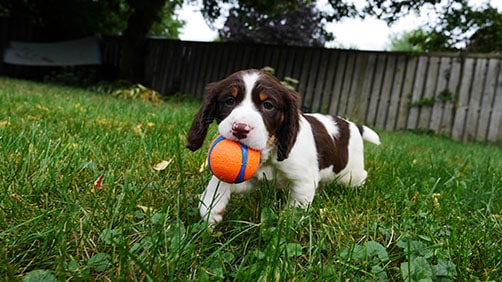
This is a picture of Sophie on the very first day I met her. You see, I met Sophie because my friend was having an extremely difficult time walking her. She would pull on the leash, bite the leash, tug on the leash, lunge at anything that moved, jump up, and bite clothes and shoes.
Does any of this sound familiar?
Although your dog’s pulling behavior might not be as bad as Sophie’s was, I want to share with you exactly what I did to train Sophie. This way, you’ll get a real-life example of how my training methods can be applied and get some insight into how to use them with your own dog.
The sad truth is that there are many ways of training a dog. And though all training methods do work in their own ways, I’m what you could call a gentle soul and have a strong belief that inflicting physical pain on a dog during training is unacceptable.
That is my own personal belief, and it has forced me to think “outside the box,” so to speak, and train using a different method—with positive reinforcements (or force-free, as some would say).
Okay, let’s get started!
TRAINING STEP #1: Eliminate Self-Rewarding Behaviors
Before I give you training advice on what to do, it’s really important that you first understand WHY your dog is pulling on the leash in the first place.
Pulling on the leash is not a natural behavior that your dog is born with. Why would a dog want to strangle himself to the point of gasping for air?
The main reason a dog pulls on the leash is because it’s a reinforced behavior. Yep, in one way or another, your dog is being rewarded for pulling (I’ll explain how below), and most dog owners aren’t even aware of it.
Let me give you an example.
John decides to take his dog to the park for a game of fetch. He knows how much his dog loves this game, plus it’s good for his dog’s health and well-being. So they start walking, and his dog pulls and drags him all the way to the park. They then proceed to play fetch for ten minutes.
This might be a pretty obvious example, but the act of playing fetch (which is something his dog loves more than anything else) will reward any behavior that occurred before, including the pulling.
If you look at it from the dog’s point of view, why wouldn’t he pull? The faster he gets to the park, the faster he will be able to play fetch. And if his owner isn’t aware of what’s happening and how this is rewarding his dog for pulling, the behavior of pulling will get worse over time.
Imagine that this scenario is repeated daily for months. This is how pulling becomes a big problem, and if nothing is done, John will end up with a sore shoulder and wrist and begin to resent walking his dog.
Here’s how you can stop this downward spiral dead in its tracks:
Whenever your dog pulls on the leash, especially if your dog is trying to get to or at something, stop walking and wait for the leash to loosen. An even bigger deterrent is to turn around altogether and walk in the opposite direction.
What does this do? Remember, your dog is pulling to get to something more quickly, and stopping, walking, or turning around creates an incentive to keep the leash loose.
This is exactly what I did with Sophie (which you can see inside my Walk in Harmony Game Plan).
Sophie would pull because she wanted to go to the park and sniff the grass. She would pull when she wanted to meet another dog or stranger or whenever there was an object on the floor she wanted to sniff and investigate.
I had to teach her that pulling would delay the time before she could get to those things. And it worked!
You can do it too. All you have to do is commit to practicing this simple exercise with your dog for the next week or month. Now, before you go ahead and try this exercise, you first have to take into consideration how long your dog has been pulling.
If your dog has been pulling for months or even years, then it’s going to take considerably longer to undo this conditioning. Pulling is like a bad habit, and habits are hard to break. It simply takes time, dedication, and consistency.
TRAINING STEP #2: Reward the Behaviors You Want
The second biggest factor that will influence your dog’s walking behavior is whether you are rewarding your dog for walking nicely with you.
You would be surprised by how many dog owners I’ve worked with who don’t actively do this. And I don’t blame them; our society has programmed us to adopt a punishment mind-set. We are used to looking for ways to punish or suppress bad behaviors.
Here’s a personal example. In one of my relationships, my girlfriend really wanted me to call her every single night. If I missed just one phone call, however, she would become angry with me and let me have it the next time I called her. She wanted me to call more often, but her approach was to punish me for not calling, so when I did call, I received lots of pain.
What do you think ended up happening? You guessed it—the frequency of my phone calls lowered until one day our relationship ended.
Traffic tickets are another example. We all know that speeding is bad and we shouldn’t do it. But let’s be honest—the real reason we don’t speed is because we don’t want to get a speeding ticket. We don’t want the burden of dealing with a police officer and having to pay the fine. And a speeding ticket will usually drive up the cost of car insurance.
Most of us want to avoid the consequences of speeding.
But what if we flipped the psychology, and instead of punishing the “bad” behavior, we rewarded the “good” behaviors?
What if a cop pulled you over and handed you $50 for driving the speed limit? Would you be more or less likely to drive the speed limit in the future? My guess is that you would be more likely to do so.
Of course, this wouldn’t be practical because it would cost a fortune. Luckily, there aren’t any limits on the amount of positive reinforcement you can give your dog. You can easily reach down and give your dog a pat on the back while saying “good dog!” for walking nicely at your side.
And here’s the kicker: the more often you reward your dog, the more your dog will want to walk nicely with you. The behavior will grow over time.
This is exactly how casinos work. A casino never forces anyone to play a slot machine, but if you walk into any casino, you will find someone playing—and most likely losing money.
How do casinos do it?
It’s simple! The casino rewards the player for playing! Everyone who walks into a casino has the dream of walking out rich, of making an extra $10,000 or even $1,000,000. That rarely happens, though. What casinos do instead is give smaller rewards randomly.
Imagine you are on your tenth play and all of a sudden your slot machine starts making noise, the siren goes off, and your machine rack up points for two entire minutes. Everyone around you smiles and congratulates you on your big win. You’re now just a little bit ahead.
And what do you do? You guessed it—you keep on playing in hopes of getting an even bigger prize.
This is exactly how you want to think when training your dog. You want your rewards to build the behavior of walking nicely with you. And it’s extremely simple to do, as I show in my Walk in Harmony Game Plan.
First, you will need to make a list of the behaviors you want to reinforce. These might include walking at your side, looking up at you, stopping when you stop walking, keeping up the same pace as you, ignoring objects on the ground, ignoring other dogs, etc.
Then simply give your dog a reward for engaging in those behaviors. The reward can be anything: saying “good dog” in a cheerful and happy tone of voice, touching and patting your dog, stopping and playing a quick game of tug, or giving your dog a delicious treat.
The key is to give the reward immediately after the behavior so your dog makes the association between his behavior and the reward.
TRAINING STEP #3: Focus on Progress Instead of Perfection
I wish I could tell you that you can get your dog to stop pulling in one afternoon. It would make a great marketing sound bite. The reality, however, is that it’s probably going to take longer than that. It really depends on how long your dog has been pulling.
For example, a dog that has been pulling on the leash for five years has developed a habit that will be harder to break than the habit of a young puppy that is just learning the rules of walking.
But no matter how long your dog has been pulling, you can change the behavior. The key is to focus on progress instead of perfection.
What you want to do is to focus on improving your dog’s current behavior. If your dog can only walk four steps before pulling on the leash, your goal should be to get your dog to take five steps without pulling.
Your goal should be to ask “a little bit more” from your dog each time you go out for a walk.
This is how professional dog trainers train dogs: they focus on the next achievable step. And this is exactly what I did with Sophie. I didn’t show up one day and have one training session, and then she was magically transformed into a Lassie. It took many training sessions with a focus on improving her walking behavior a little bit each day.
In fact, I kept a written journal of every training session I had with her, and I would highly recommend that you do the same.
Here is what it looks like:
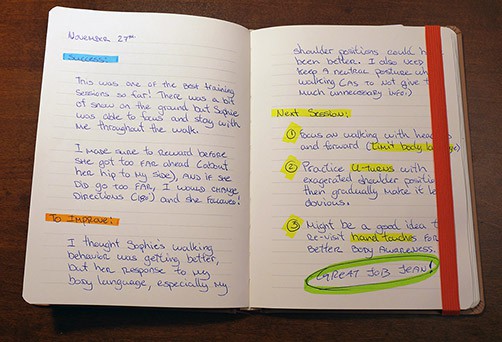
It’s very simple. All you have to do is write three things:
- What went well during the training session (or walk). I’m a firm believer in celebrating successes no matter how small they are. This acknowledgement is also going to give you the emotional juice to keep going.
- What didn’t go well during the training session (or walk). This will be really easy to remember, but I still urge you to write it down. Why? If you write it down, you won’t have to remember it. It’s like Einstein said: “Paper is to write things down that we need to remember. Our brains are used to think.”
- What you need to work on in the next training session (or walk). This is the most important thing to write down, so try to do it immediately after your training session (or walk). Doing so will make your brain think about a solution rather than dwelling on the problem.
And if you are a more advanced trainer, you may even want to videotape your training sessions. That way, you can review the footage and even ask for advice on possible training solutions. For the vast majority of dog owners, though, this isn’t practical or necessary.
All you need is a simple notebook to use as a training journal.
This is why my Walk in Harmony Game Plan is so effective: because I went through this process with Sophie and kept a written record of every one of my training sessions with her. I could open up my training journal right now and tell you exactly what I did during each training session.
TRAINING STEP #4: Play Training Games to Strengthen Skills
Did you know you can improve your dog’s walking behavior without ever leaving the house? Yep, all you have to do is work on teaching your dog the following five skills:
- Attention
- Self-control
- Obedience
- Loose leash manners
- Body awareness
What are these skills?
They are skills that you can teach inside your home where there are no distractions, and then once your dog has mastered them, you can utilize them outside to make walking your dog easier.
For example, you can teach your dog to look up at your face. How useful would this be? Well, next time you are walking past a distraction, you can say “look at me,” and your dog will look at you instead.
Or how about teaching your dog to control his instinct and not lunge or pull toward things on the ground? This is exactly what happens when you strengthen this skill.
So how does it work?
Simple. All you have to do is set aside ten to fifteen minutes a day and teach your dog a particular skill.
I lay out all of my skill-building training games in my Walk in Harmony Game Plan, but here is one I played with Sophie. The objective was to teach her to ignore a pile of popcorn on the ground.
(Click the play button below to watch the video.)
As you can see from the video above, Sophie was quite persistent in the beginning. By the end of the training session, however, she had much better self-control. Imagine if you worked on this every day for a week or a month how much better your dog would be!
PART 2:
In the second article of this series, I’m going to share five reasons why you should train your dog to walk on a loose leash (and to stop pulling) that are incredibly important. As a loving pet parent, you absolutely need to be aware of them. Click here to read part two.
The Ultimate Guide To Training A Dog To Come On Command
Does your dog ignore you when you call him? And does he respond only after you’ve called him maybe three or four times?
You’re not alone—I understand what you’re going through. You see, my dog, Onyx (a purebred Siberian husky), wasn’t always the perfectly behaved dog she is now. There was a time when she would completely ignore me when she was in the backyard sniffing the grass.
I would have to call her four or five times before she even looked at me. And it was so frustrating because I knew she could hear me, yet she was choosing to ignore me and continue sniffing the grass.
So, in this short article, I’m going to share three of the most important lessons I learned while training Onyx to come to me on command.
Lesson #1 – Understanding your dog’s point of view.
Whenever you call your dog to you, the dog has a choice of either dropping whatever he’s doing and coming to you or continuing what he’s doing at the moment (like sniffing the grass.)
Every time you call him, your dog will evaluate the positives and negatives of this choice.
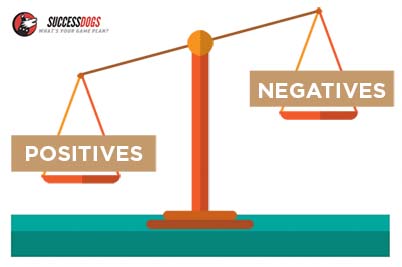
For example, if your dog believes that you’re going to give him a delicious steak if he comes to you, this belief most likely will dwarf any other choices in his mind.
Your dog will evaluate the options: sniffing the grass or eating a steak. Simple choice, right?
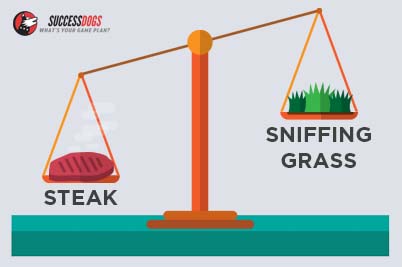
Yet many dog owners don’t realize that this process of choice also operates in reverse. For example, if your dog believes you’re going to punish him and yell at him if he comes to you, it will be an easy choice to keep sniffing the grass.
So whenever you want your dog to come to you, think about what’s in it for your dog. I’m not saying you should bribe your dog to come to you, but you do have to be aware of what you’re offering your dog.
Praise and play go a long way. Imagine if you gave your dog total undivided attention for sixty seconds every time he came to you by playing tug-of-war or having a wrestling session. That would totally change his perceived value of coming to you.
You also have to be aware of what your dog is doing and how much of a reward it is when you call him to come to you. Remember—not every reward has equal value in your dog’s mind.
For example, let’s say your dog is running after a squirrel in the backyard. The reward level for this activity would be through the roof; even a steak might not be enticing enough to get him to stop chasing the squirrel.
So, with Onyx, who loves to sniff the grass in my backyard, I know that she gets the most value from this behavior in the first five to ten minutes. After this amount of time, it becomes a little boring for her, and this presents me with the best opportunity to call her to me.
Training your dog to come on command is a game of balancing what you offer (giving your dog a reward after coming to you) and requesting the behavior at the appropriate time (when the self-rewarding behavior is at its lowest value, or when you believe your dog will choose you instead of his current activity).
Whenever either one of those actions is out of whack, your dog isn’t going to choose you.
Lesson #2 – Coming to you is a loss of freedom.
You also want to be aware of what happens after you call your dog to you. Dogs are a lot smarter than we give them credit for, and they will make the connection about what happens after they come to you.
For example, you’re at the dog park and your dog is having an exciting time with other dogs. You realize it’s time to go, and you call your dog to you.
Over time, your dog is going to make the connection that coming to you is not a great choice because all the fun stops, the leash is put on him, and he has to go back home.
So you have to become unpredictable. You have to sometimes call your dog over only to give him a reward and let him go back to whatever he is doing.
This is why I’m such a big fan of playing training games with dogs, as they teach dogs to come on command and there are no drawbacks. The dog doesn’t think he will lose his freedom; he comes to you because it’s pleasurable.
This is a lesson I describe in my Fido, Come training program (which you can learn more about here).
Lesson #3 – Timing is everything.
Did you know that you can train your dog to come using any word or command? You could literally train your dog to come to the word “banana” or “spider.” The word itself is meaningless.
Your dog learns to come to you after hearing a particular word only because he’s been conditioned to do so. Maybe you’ve done this consciously or unconsciously, but there must always be a particular sequence of events for your dog to respond to a command.
The proper sequence is:
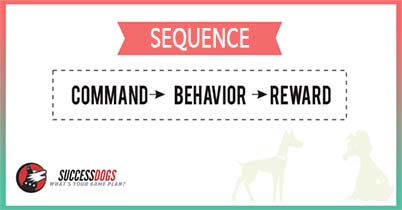
So for training your dog to come, the sequence would be:
COME COMMAND > DOG COMES TO YOU > GIVE TREAT
Pretty simple, right?
But the key for this command to work is that you must have proper timing. This means that every event in the sequence must occur in close proximity to the next event.
For example, if you give your dog a treat five minutes after coming to you, he’s not going to make the connection that the treat is a reward for coming to you.
The same is true if you call your dog to come to you and he comes to you five minutes later. Even if you give him a delicious steak, he’s not going to learn the command, because the time duration between events is too long.
Ideally, you want your dog to respond within five seconds of your calling him and you want to give him the reward immediately after he gets to you. The quicker everything happens, the better.
Your dog isn’t really going to know what your command means at first. This is why I always tell my students to play my “Boomerang” training game, which is a super-simple way of teaching dogs to come after hearing a command.
Here is an example:
This training game should be the foundation for every other training game you play with your dog.
Dog Training Infographic Version 2 – The Four Stages of Luring
I published my long-awaited training concept about the four stages of luring a few days ago. You can learn more about how it works and how you can use it to train your dog on this page.
When I designed this infographic, I wanted two distinct versions. The first one was to be given to my students so that they can print it and refer to it while training their dog.
The other was to be a graphic-oriented infographic, where people could share it on social media sites such as Facebook and Twitter, or post it on their website.
Here is the second version:
(Click the photo to enlarge, and check out the sharing instructions at the bottom of this page.)
Share this image on your site:
[infographic_share_1]Share this image on social media:
[social_sharing style=”style-14″ fb_like_url=”https://www.successdogs.com/jeans-blog/dog-training-infographic-luring/” fb_color=”light” fb_lang=”en_GB” fb_text=”like” fb_button_text=”Share” tw_lang=”en” tw_url=”https://www.successdogs.com/jeans-blog/dog-training-infographic-luring/” tw_name=”successdogs” tw_button_text=”Share” g_url=”https://www.successdogs.com/jeans-blog/dog-training-infographic-luring/” g_lang=”en-GB” g_button_text=”Share” alignment=”center”]If you would like to download the printer-friendly version, visit the four stages of luring training concept page.
Training Concept: The Four Stages Of Luring
In this post, I’m going to discuss in great depth the four stages of luring, a common training technique to get your dog to do a specific behavior such as sitting, lying down, or rolling over.
Luring is extremely easy and will work with any dog that is food motivated. You place a piece of food inside your hand and position it next to your dog’s nose. Because your dog will want the food, it will begin to sniff your hand. While your dog is interested in the food, you can move your hand in different positions to prompt your dog to get into a certain position.
For example, you can move your hand upward and toward your dog’s ears to get it to sit or move your hand down and toward its paws to get your dog to lie down. It’s a useful technique available to anyone wanting to train a dog by using positive reinforcements.
However, it does have its limits. You cannot use luring to counter-condition an existing behavior such as barking or pulling on the leash. And you cannot use it to teach your dog an intricate behavior such as playing chess or retrieving a ball.
Luring is the first technique I learned to train my dog with. I learned it while attending dog training classes here locally. And I will never forget the moment when I was finally able to communicate what I wanted to my dog. So that my dog learned to instantly respond to my “sit,” “down,” “stand,” and “get in” commands.
In fact, here is a short video of those four behaviors taught using this technique:
THE DIAGRAM:
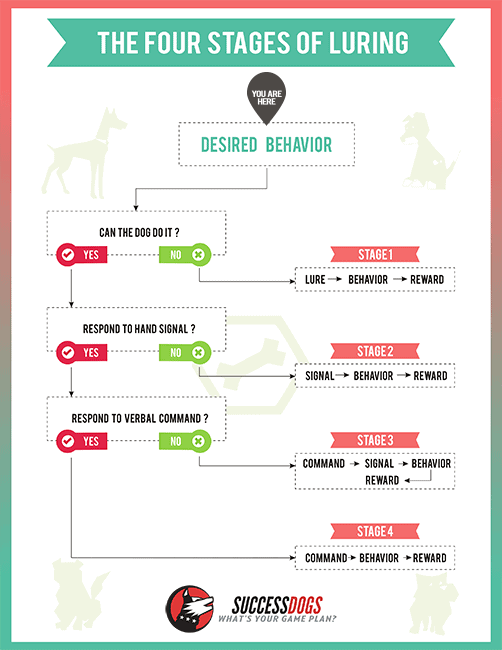
I created this diagram to help you understand more clearly luring process and how you can get to the point where your dog responds to your verbal commands.
The first step, as indicated by the “YOU ARE HERE” marker in the image above, is the behavior you want your dog to do.
Whenever you use this diagram, you must think about one specific behavior you want to train. This is what I call the “desired behavior.” Then you go through the questions on the left, and if any of the answers is “no,” then this is the stage you need to work on.
I will explain each stage in detail below.
STAGE 1:
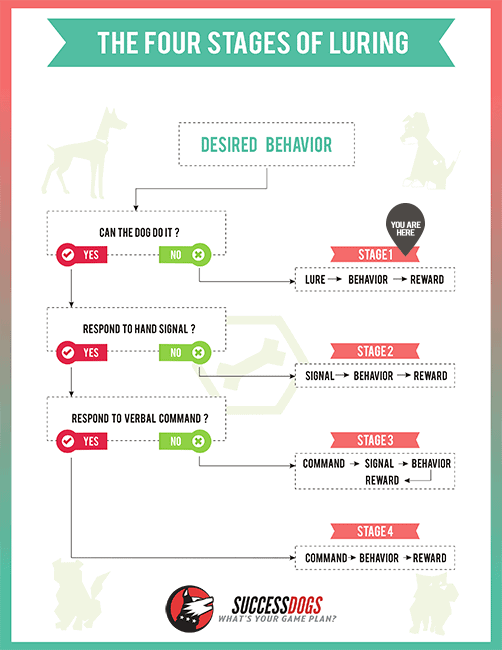
Once you’ve figured out exactly which behavior you want to work on, then you must ask yourself the first question: “Can the dog do it?” This question is in relation to your ability to lure the dog into that position. For example, if your desired behavior is getting your dog to sit, well, every dog is able to sit at some point. But can your dog do it in relation to the lure? The question really should be, “Am I able to consistently lure my dog into this position?” but it didn’t fit inside the diagram.
So if the answer is “no,” then this is where you need to begin.
You will need to pick a food that your dog absolutely loves, something that it only gets as a treat, like a piece of chicken or sausage. Then place this food inside the palm of your hand and close your hand like a fist. Your dog will be able to smell the treat but won’t be able to eat it.
And the way this stage works is this: You move your hand while your dog is sniffing it. This is essentially what luring is. Because your dog is trying to get to the food, it will follow your hand. Your goal here is to move your hand in a way that gets your dog in a particular position.
So, for example, if you wanted to get your dog to sit, you would move your hand upward and toward your dog’s ears.
Now, the secret for this to work with your dog is all about when you release the treat. This is what is going to communicate to your dog: Whatever behavior you just did is what earned you this treat.
So to reward the sit, you would immediately open your hand and give your dog the treat after its behind touches the ground. And when you do this over and over, your dog will quickly learn that the fastest way to get the treat is to sit down.
There is also the option of giving a marker signal once your dog gets into the desired position. A marker signal can be either the word “yes” or the sound of a clicker. In this stage, a marker signal is not needed because releasing the treat once the dog gets into the desired position is enough for a dog to understand what you want.
STAGE 2:
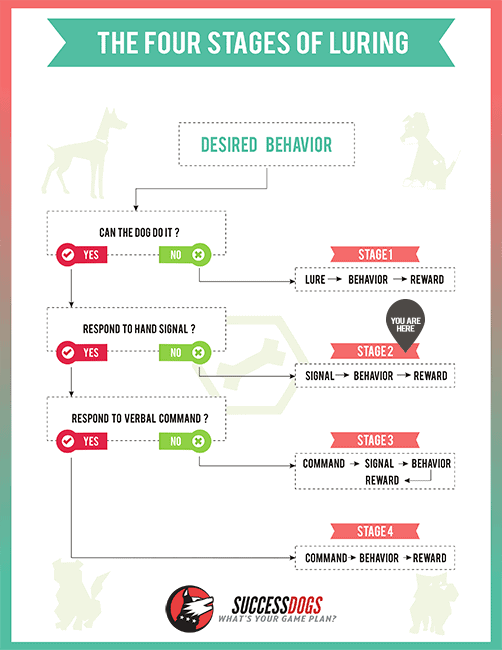
Okay, it’s time for the second stage. This is where you teach your dog to respond to a hand signal. You need to teach your dog a unique hand signal for every specific behavior. For example, sitting is an upward motion with the palm of your hand facing upward.
Teaching your dog a hand signal has numerous benefits, the main one being preventing your dog from becoming dependent on you having a treat in your hand for it to do the behavior. Another reason is that you want your dog to learn your body language so you can communicate at a distance.
I remember when I taught my dog Onyx to respond to all of my hand signals for the obedience behaviors. She would lie down, sit, stand, come, and sit at my side without me ever having to say anything. I thought it was the coolest thing ever.
And this is why I love this stage so much: You are effectively communicating with your dog with just the use of your body. Dogs are extremely visual, and they can notice the slightest change in your physiology.
To teach your dog a hand signal, you will have to do it gradually because if your dog is used to following a lure, and all of sudden you use a hand signal, your dog is not going to understand.
That’s why you must first create a pattern so your dog will be successful. This is done by luring your dog three times in a row (the same way as described in stage one). Then, on the fourth repetition, take the food out of your hand and move your hand the same way as a lure.
This works well because you’ve just rewarded your dog three times in a row for getting into the position. And your dog is smart; it will anticipate that you want the behavior repeated. So even though there isn’t any food in your hand, your dog is still going to do the same thing.
This is what is called a 3:1 ratio; you lure your dog three times in a row, each time followed by a hand signal. Then continue practicing until you can lower the ratio to 2:1, then 1:1 and, eventually, you phase out the lures altogether.
What is important to note here is that this is a gradual process; it won’t happen overnight. You need to make sure your dog is successful. If you try to give your dog a hand signal over and over, and the dog fails, you’re both going to become frustrated. That’s why you have to take it one step at a time.
From my years of experience teaching hand signals, I would like to share one more key distinction with you. Whenever you give your dog a hand signal, and it responds by doing the behavior you want, you should always bring your treat to your signal hand before giving it to your dog. This will keep your dog focused and attentive to your signal hand because that is where the treats are.
Once your dog consistently responds to your hand signal and is no longer dependent on the lures, you will want to move on to the next phase, which is to refine your hand signal.
For example, a hand signal in the beginning might look more like a lure with the hand closed and close to the dog’s nose. But then you will want to make refinements to that hand signal and open your palm and face it in a certain direction.
What you want to do is make one small change at a time. Once your dog is successful, continue refining your hand signal. You can continue doing this until you have the perfect hand signal you want. It’s totally up to you.
You will also need to do the same thing with distance. Begin with a hand signal next to your dog’s nose and gradually increase the distance until you are a foot or two away.
STAGE 3:
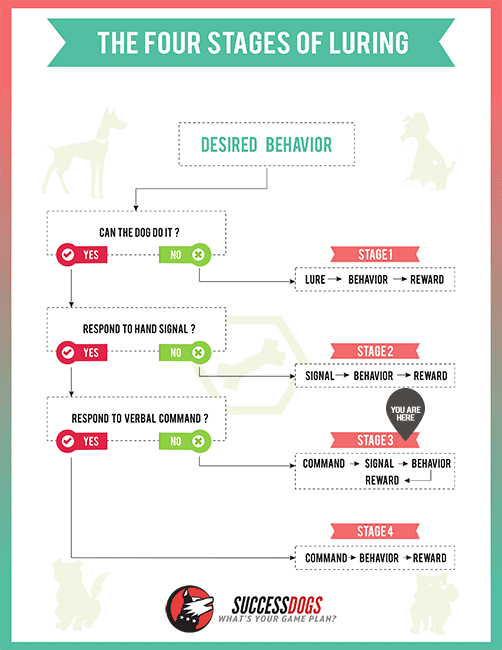
This might surprise you, but did you notice that I didn’t mention anything about a verbal command in the first two stages?
The reason is that dogs have no idea what a verbal command means until it’s been associated with a certain behavior. In fact, dogs don’t understand the commands “Sit” or “Down.” You could train your dog to sit when you say “Banana” if you wanted to. The word itself is meaningless.
The way dogs learn a verbal command is through repetitions in which the dog learns to offer a specific behavior after hearing the command in order to get the reward. It’s that simple.
And I have some great news. Most of the hard work is done in the first two stages in which you teach the dog the behavior and the hand signal. Once you can consistently and easily signal your dog into a position, then all you have to do is say your verbal command just before giving your hand signal.
Here is an example: In stage two, you would begin by giving your dog the signal for sitting. Then your dog would sit. And then you would give it a treat.
Now all you have to do is say “Sit.” Then give your hand signal and, once your dog sits, you give it a treat. Your dog will learn through repetition that every single time you give your verbal command, the same hand signal is given afterward. Eventually, your dog is going to start doing the behavior before you even have a chance to give your hand signal.
Simple, right?
There are a few important details that I would like to bring to your attention. First, make sure that you say your verbal command without using any body language. This means that, before you say your verbal command, make sure that you stand tall with your arms and hands at your side.
Most dogs are primarily visual, and they will pick up on any subtle body language, so if you nod your head every time you give the command “Down,” your dog might be responding to the nod rather than the verbal command.
Second, you must always say your verbal command before giving your hand signal. It won’t work if you say it at the same time, and this is a common mistake new trainers make.
Third, and this is a little more advanced, but my guess is you want to master this training method, or you wouldn’t have read this far. You will want to randomize your repetitions. And what I mean by “randomize” is this: Instead of doing the same thing over and over at the exact same pace, try to increase and decrease the length of time between repetitions.
For example, you could do one repetition, then move around a little bit to distract your dog, then do another repetition. This randomization will keep your dog attentive to the initial trigger, which is your verbal command.
STAGE 4:
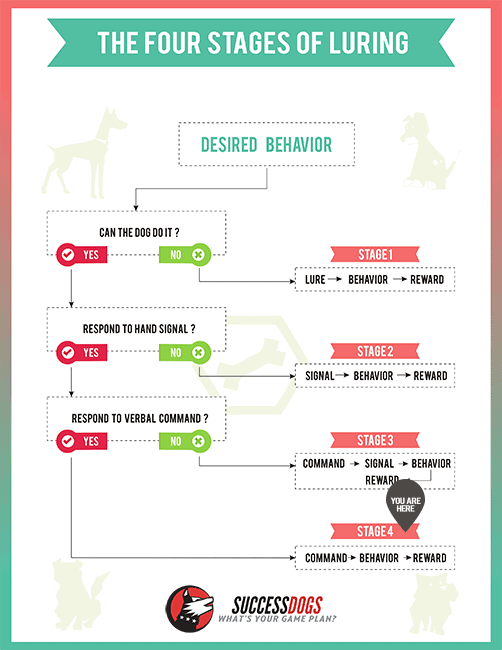
The final stage is all about phasing out your hand signal. You can continue working with the hand signal if it’s something you want to use with your dog, but my bet is you want your dog to respond solely to your verbal command.
Before you can begin phasing out the hand signal, it’s important that you’ve practiced the stage three exercise enough times that your dog is starting to perform the behavior before you have a chance to give your hand signal. This is what tells you when your dog is ready.
Do you remember how we created a pattern in stage two when we started with a 3:1 ratio: three lures to one hand signal?
You’re going to use this same principle in this stage to phase out the hand signal. The purpose, if you recall, is to create a pattern so your dog will be successful. If your dog does something three times in a row, the dog will most likely do it a fourth time.
So begin by creating a pattern with a 3:1 ratio. Practice giving your command three times in a row, followed by a hand signal, and then reward your dog for doing the behavior.
But on the fourth repetition, you will want to give your verbal command without giving a hand signal. Then wait: If your dog performs the behavior, make sure you celebrate; give your dog a treat and lots of praise. Your dog has effectively responded to your verbal command.
But this doesn’t always work on the first try. Sometimes you might need to give a slight hint of the hand signal, such as slightly moving your shoulder or arm. But the goal is to get your dog to respond solely to your verbal command. So be sure this doesn’t become a habit.
Once you are successful with a 3:1 ratio, the only thing left is to gradually reduce this ratio to 2:1, 1:1, and eventually phase out the hand signals altogether.
CONCLUSION:
I understand this might seem overwhelming, especially if you’re just starting out. It’s like learning how to drive a car. If you remember, it was hard, and you had to pay attention to so many things, but now you can do it without even thinking about it.
The same is true with this training method. Once you’ve gone through all four stages with your dog, you’ll say to yourself, “Ah, that was easy!” And it is, but you have to start somewhere.
So choose a behavior you’d like to teach your dog—something simple such as sitting. Begin with stage one, and work your way from there. If you would like to see specific examples, such as how to lure your dog into a sit position or what my hand signal looks like, you are welcome to get my Good Dog Every Day Program that demonstrates how I work with my own dog.
I look forward to hearing about your success with this training method.
What’s your greatest dog training moment?
So this blog post is going to be a little different than most…
The reason why I created this website and the reason why I do what I do in the dog training world, is because I want dogs to live better and happier lives. And I wholeheartedly believe that positive reinforcement training is the best way to achieve this.
Unfortunately, not everybody agrees. So I thought, what if we have a page on this site that is full of dog training success stories. Stories about how our dog’s lives transformed, how they happier and better behaved as a result of training this way?
For example, when I first started training my dogs to do tricks, I thought my dogs were only doing it because I had a treat in my hand. But then I realized how much my dogs LOVED the training, how their tails were wagging in excitement the moment they saw me with a clicker or preparing training treats.
And how it brought me closer to my dogs than I ever could have imagined. I remember training my dog Chase to put her head on my lap while watching TV one day, and she was doing it for praise. I thought it was the coolest thing!
So I have a favor to ask you…
Would you mind sharing with me your story about how life changed as a result of training your dog with positive reinforcements? You can talk about a special moment, a funny story or anything you want.
I look forward to reading it! (Thanks in advance!)
Free Dog Training eBook – The Power of Positive Reinforcements
Have you ever wanted a dog so behaved and well-trained that people compliment on his awesomeness?
Well, this is exactly what happened to me when I started training my dog with Positive Reinforcements (this is a fancy name for reward-based, force-free training.)
Friends and family started to compliment me on how well-behaved my dog was, and how much they loved her because of all the amazing tricks she could now do. And once I taught my dog how to play chess (yes, I taught her that!), I just knew that this training method was the most powerful thing on earth.
And this is why I wrote this eBook that I’m giving away for free – the Power of Positive Reinforcements.
I want you and all dog owners around the world to experience this way of training. Because it simply works – some of the world’s greatest dogs were trained using this method. And best of all, dogs absolutely LOVE it! (And it even brings you closer to your dog!)
You’ll discover inside the eBook…
- Your dog’s deepest desire (page 23) – Without it, you will never be able to effectively train your dog to do anything. (Think of it like being paid for a job well done – you have to figure out what motivates your dog so you can get him to do … what you want him to do!)
- Training your dog to come (page 26) – This is the MOST important skill you can ever teach your dog … think about it, what would happen if your dog got loose near a busy street? You need a way to get your dog to come back to you!
- Walking on a loose leash (page 34) – It is a well-known fact that lack of exercise leads to destructive behaviors. And the easiest way to exercise your dog is to WALK your dog … but who wants to go on a walk while getting dragged down the road?
- Avoiding food possessiveness (page 39) – Perhaps you’ve already noticed that your dog doesn’t like having you near his food bowl … but did you know that there’s something you can do about it? In fact, you can even get your dog to LOVE you being near it.
- Grooming your dog (page 43) – Brushing and taking care of your dog’s coat is extremely important – but how many dogs hate it? The simple exercises in this section will help solve that problem forever!
- Obedience training (page 50) – Want your dog to listen to your “Sit”, “Down” or “Stand” command? Simply follow the step-by-step instruction in this chapter and you’ll get your very own Lassie!
- Teaching your dog tricks (page 58) – What would the world be without dog tricks? They entertain us and dogs absolutely LOVE doing them … so why not take a few minutes of your day and teach your dog some of the best dog tricks?
And this is just a small sample of what is inside the eBook. Again, I wrote this eBook because I wanted to spread the word about Positive Reinforcement training and how much of a difference it can make in your dog’s life.

(a $47 value yours free!)[/optin_box_field][optin_box_field name=”paragraph”]PHA+RW50ZXIgeW91ciBpbmZvcm1hdGlvbiBiZWxvdyB0byBjbGFpbSB5b3VyIGZyZWUgY29weS48L3A+Cg==[/optin_box_field][optin_box_field name=”privacy”]Your information will never be shared with anyone.[/optin_box_field][optin_box_field name=”top_color”]undefined[/optin_box_field][optin_box_button type=”0″ button_below=”Y”]Send Me The eBook![/optin_box_button] [/optin_box]
If you enjoyed reading this eBook, please share it with your friends by clicking the Facebook Like button located on the left hand side of the page.
The more we share this eBook, the more people will be able to train their dog using positive, force-free and reward-based training methods!
The Collar Grab Training Game
Last week I published three dog training tips to help you train your dog. These training tips are not meant to be full courses but rather “golden nuggets” of information.
One of them was about training your dog to come, and more specifically one technique that I discussed was the “Rocket Launch”. Where you have a friend hold your dog and you call your dog and run in the opposite direction to trigger your dog’s chasing instinct.
You can actually read more about the “Rocket Launch” technique by clicking here.
What I enjoy about publishing these dog training tips is the interaction that I get with other dog owners. I can read about their struggles and help them. And this is what happened; I received some interesting questions about a variety of subjects.
One question in particular was about training a dog to come close and being able to put a lead on.
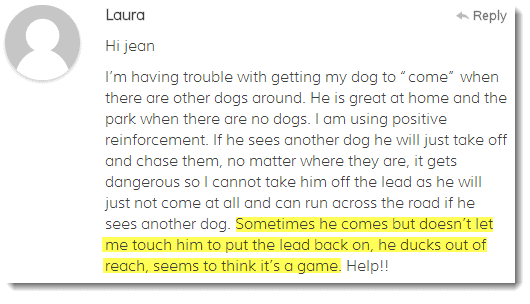
So in response to Laura’s question, and anybody who might have the same issue, I’ve decided to take one of the lessons from my Walk in Harmony Game Plan and share it with you for free.
This training game is called “The Collar Grab Game”. And basically you want to condition your dog that great things will happen when you grab your dog’s collar.
Because here is the thing; most dogs learn over time that coming back to you (or their owner) is something to avoid because it leads to a loss of freedom.
Think of it from your dog’s perspective. If your dog is playing freely in a park, and it’s finally time to go home, what do you do? You call your dog to you, put the leash on your dog and go home.
But over time, your dog will learn this pattern. And you may already be experiencing some side effects of that with your dog starting to “ignore” your come command, or not fully coming all the way to you and staying a few feet away, or running away when you try to put on the leash.
So to counter-act this, you simply have to play “The Collar Grab Game”. Basically you take your dog’s collar, give your dog a treat, and then release the collar. Simple right?
Here is the video:
So when can you use this? You’d want to use this when practicing recalls; get in the habit of grabbing your dog’s collar whenever your dog gets to you. Of course sometimes put the leash on, and other times release your dog.
There’s times when I’m at the park and I purposefully practice this game with my dog. I would call my dog to me and then grab the collar, put the leash on, give her a treat and then let her go back to play.
So have fun! And let me know how it goes by writing a comment below. (Yes, I read them all.)
Fun, Effective Technique To Get Your Dog To Come … The Rocket Launch!
I want to tell you about something that is extremely important, something that could literally save your dog’s life one day … and something that is easier than cooking Popcorn!
What is it you ask? It’s teaching your dog to come after hearing his name. But you’d be surprised to know that most dogs have never been conditioned to respond to their name. Most people simply assume their dog know their name because “we” as humans do.
This exercise is great for teaching your dog to come to you after hearing his name. I remember teaching this to a friend a little while ago, and in a weekend their dog would come running to them like had just been selected on the “Price is Right”.
She did the exercise with her son. They would call their dog’s name and give a treat after he came to them. That’s it. But then they built upon the exercise, started creating distance between each other until they were in separate rooms. Then they even practiced on two different levels of the house – meaning one of them was upstairs and the other downstairs.
So if they could teach their dog to respond to his name in one weekend, surely you can too!
Make sure that you give your dog something that he values when he comes to you, most dog loves food but it could be other things like playing, petting and giving attention.
BUT I MUST WARN YOU …
Your dog’s name will become a conditioned cue to get your dog to come to you, meaning that if you use it uselessly around the house without giving your dog a reward, it will lose its effectiveness.
If you say “FIDO, GET OFF THE COUCH!” or “FIDO, DOWN!” or “FIDO, GO GET YOUR TOY” then the word “Fido” does not mean to come to you anymore, and you are using it to get your dog’s attention.
So what is the solution? There are three options:
- Do not use your dog’s name unless you want your dog coming to you.
- Train your dog to the command “COME” instead of his name.
- Use a nickname whenever you don’t want your dog to formally come to you..
Personally, I practice all three solutions with my dogs. I don’t use their names unless I want them to come to me, and they’re also conditioned to respond to the “COME” command, and I use little nicknames around the house for them.
Go ahead, give it a try with your dog! Seriously … just do it, it will work!
Power Quote: “Teaching your dog basic obedience skills is your responsibility as a dog owner, but teaching them can be lots of fun if you use Positive Reinforcements.” – Jean Cote

